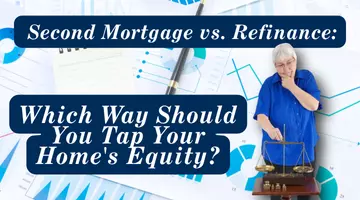Second Mortgage vs. Refinance: Which Way Should You Tap Your Home's Equity?
By Cindy Ulsrud | Porchlight Properties | Realty Executives Cooper Spransy
As a homeowner, you'll likely reach a point where you need to access the equity you've built up—whether it's for a major home renovation, debt consolidation, or covering other big expenses. The big question is how to do it.
The two most common methods are taking out a second mortgage or doing a full refinance. Both strategies unlock your home's value, but they operate very differently, and the long-term costs of one may surprise you. Choosing the right path is crucial to your financial health.
🔑 Key Difference: One Loan vs. Two Loans
The most fundamental difference is simple: a refinance replaces your existing loan with a new one; a second mortgage adds a new loan on top of your existing one.
- Second Mortgage: You keep your current mortgage and interest rate, and you take out a separate, junior loan (like a Home Equity Loan or HELOC) against your equity. This means you will have two separate monthly payments.
- Refinance (Cash-Out Refi): You pay off your original mortgage with a larger new loan. You get cash from the difference, and you have one new monthly payment that replaces the old one.
🔪 When a Second Mortgage Is the Smarter Move
If you secured a remarkably low-interest rate on your original mortgage, a second mortgage often makes the most sense. It allows you to access cash without sacrificing that low rate.
A second mortgage is a strong option when:
- You love your current rate: You keep your low first-mortgage rate intact, which is often the biggest financial advantage.
- You need a set amount: It's great for specific projects or debt payoff; you borrow a defined amount (Home Equity Loan) or a revolving line (HELOC).
- You want a faster process: Second mortgages generally have lower closing costs and faster timelines than a full refinance.
- You plan to pay it back fast: Since it's a separate loan, you can pay it off quicker than restarting a new 30-year mortgage.
Quick Gut Check: If your current first-mortgage rate is at least one full percentage point lower than current market rates, a second mortgage usually wins on total cost.
💰 When Refinancing is the Better Option
Sometimes, simplicity and lower overall rates are the best choice. A refinance is ideal if you want to overhaul your debt structure and your existing rate is high.
A refinance is the better choice when:
- Market rates are low: If today’s market rates are significantly lower than your current rate, a refinance can save you money every month.
- You want one clean payment: It consolidates all your home debt into a single, predictable monthly bill.
- You want new loan terms: It allows you to change terms, like moving from a 30-year loan to a 15-year loan, or switching from an Adjustable-Rate Mortgage (ARM) to a fixed rate.
- Your financial health has improved: If your credit score or income has improved, you may qualify for better pricing on a new prime mortgage.
Break-Even Tip: To know if a refinance is worth the high closing costs, divide the total cost by your expected monthly savings. If you plan to live in the home longer than the resulting number of months, the refinance will pay for itself.
🛑 Long-Term Impact & Risks You Must Know
Your choice impacts more than just your monthly payment—it shapes your long-term equity growth and future borrowing power.
Equity Growth
- Refinance: Resets the amortization clock. Your new loan starts over, and your payments primarily go toward interest in the early years, slowing your equity growth.
- Second Mortgage: Your original amortization schedule remains intact. You continue building equity quickly on the first loan, even while paying off the second.
Key Risks
Second Mortgage Risks:
- You have two payments to manage.
- The second-mortgage rate is often higher than your first.
- You reduce your equity safety cushion.
Refinance Risks:
- You lose your existing, potentially low, rate.
- Closing costs can take years to recover.
- Restarting the clock increases the total lifetime interest paid.
✅ The Final Decision
Don't choose based on a hunch. Run the numbers for both options, including all fees, and apply the break-even test.
- If your current mortgage rate is a keeper and you need a specific amount of cash, a second mortgage is typically the sharper financial tool.
- If market rates have dropped and you want a single, lower payment with new terms, a refinance can lower your total housing cost.
The right choice is simply the one that saves you the most real money without putting undue stress on your future budget.
GET MORE INFORMATION




